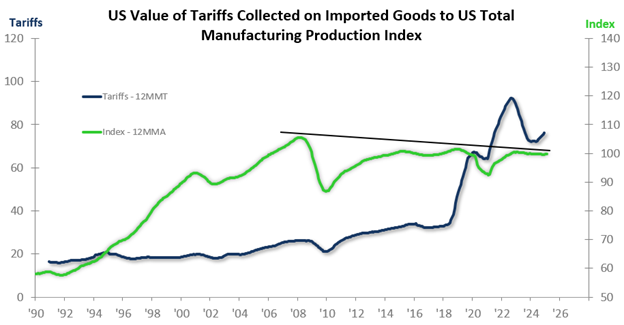As of April 2, a new round of tariffs has been announced. In alignment with prior tariffs, there will be some businesses that benefit from these tariffs and others that are impeded by them. We will dive further into the impact on the specific markets in future conversations. For the moment, we are focusing on the macroeconomic picture - US Manufacturing Production.
To set the stage, here are some of the headline-grabbing tariff announcements from April 2:
- The tariffs are cumulative.
- One example of this is China. Goods coming in from China are now facing a 54% tariff. That is taking the 20% tariff that had been applied to fight fentanyl and adding a 34% reciprocal tariff announced on April 2.
- A 10% tariff on all countries goes live on April 5.
- Higher individualized reciprocal tariffs will go live on April 9.
- The existing fentanyl/migration tariffs for Canada and Mexico are unchanged.
- USMCA-compliant goods will still be subject to a 0% tariff, while non-USMCA-compliant goods will be subject to a 25% tariff, and non-USMCA-compliant energy and potash will be subject to a 10% tariff.
- Not all goods will be impacted by the Reciprocal Tariff.
- Items subject to 50 USC 1702(b); steel/aluminum articles and autos/auto parts already subject to Section 232 tariffs; copper, pharmaceuticals, semiconductors, and lumber articles; all articles that may become subject to future Section 232 tariffs; bullion; and energy and other certain minerals that are not available in the United States are currently not impacted by the reciprocal tariffs.
Tariffs and US Manufacturing: A Disconnect
The tariffs instituted during President Trump’s first term were designed to protect American industries from foreign competition and incentivize domestic production. However, the tangible benefits have been elusive. Data suggests that manufacturing output did not see the anticipated boost. Instead, manufacturers faced higher costs for imported materials, leading to squeezed profit margins and a complex, less efficient supply chain.
The below chart shows the US Value of Tariffs Collected on Imported Goods in blue and the US Total Manufacturing Production Index in green. The black line running across the top of the green line shows that the Manufacturing Production trend has had descending peaks since the Great Recession and that there was no discernible uptick in US Total Manufacturing Production during the first Trump administration tariffs.

The ITR Economics team went into greater detail about the trade war impacts, supply chain impacts, and the long-range outlooks for the US and global economies during the 2030s in preparation for the March 2025 Summit. The US has seen a noticeable increase in onshoring during the past few years as businesses work to strengthen their supply chains, and our analysis on the 2030s outlook indicated that tariffs could be putting the overall US economy in greater danger.
To listen to the recordings of the ITR Summit and learn more about the impact of increasing manufacturing within the US economy, click here. If you would like to discuss what this means for your business specifically, please reach out at any time.